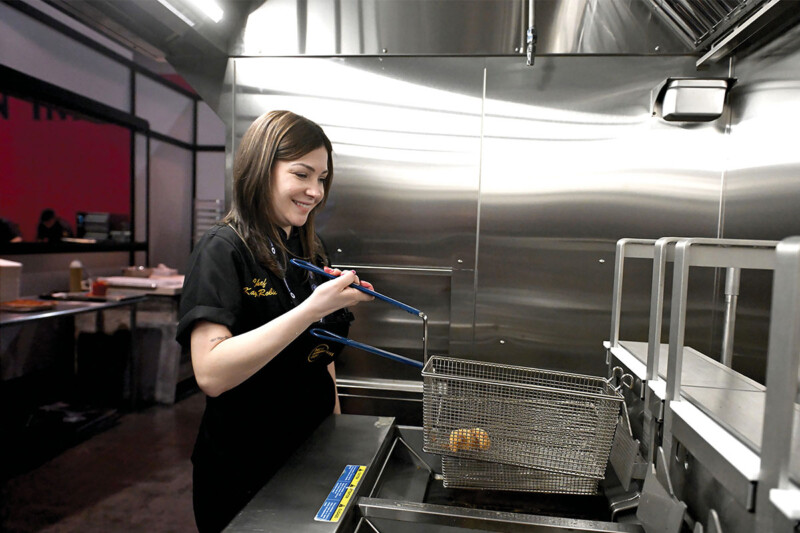Increasing environmental regulations require you manage the disposal of fats, oils and grease with extra care. FOG generally is regarded as an environmental problem, and many municipalities impose fines when you fail to keep FOG out of your sewage lines. To get the job done, manufacturers offer three types of grease interceptors (or traps)—automatic, hydromechanical and gravity—all of which are designed to collect FOG and come in a variety of sizes to match FOG output and satisfy local regulatory requirements.
Grease interceptors have different maintenance requirements, some of which can be done by trained in-house staff; others require outside servicers. But in all cases, proper grease-trap maintenance begins with prevention.
Dry-wiping kitchen wares generally is the most important step in preventive care. Teach your staff to dry-wipe grease from kitchen ware (pots, pans, etc.) into grease receptacles prior to washing; don’t let them dump quantities of grease down the drain. To prevent unnecessary grease emulsification through detergent and degreasing-agent overuse—especially as emulsification reduces the trap’s efficiency by inhibiting its natural tendency to collect—install automatic detergent/agent dispensers when possible. And because the kitchen mop bucket usually is emptied into the same plumbing system, train your staff not to overuse detergents and degreasing agents when cleaning floors.
Automatic grease interceptors: Although you should follow the manufacturer’s maintenance instructions, most automatic grease traps require that staff clean any food particles or sediment out of the trap’s filters daily. Because they include moving parts—such as skimmers that direct grease into a receptacle—as well as heating elements and circuitry, automatic units are more likely to fail from lack of maintenance. Many manufacturers’ specifications require regular circuitry inspection, which calls for scheduled, professional service.
Hydromechanical grease interceptors: Ensure that trained staff services your hydromechanical grease trap a minimum of one to two times per week, depending on grease output. Hydromechanical units should be disassembled completely and all of their parts cleaned thoroughly. Because this is a messy and unpleasant job, staff frequently takes a shortcut and simply skims the grease floating on the water in the unit rather than perform a thorough cleaning; eventually the unit’s baffles get overloaded. Combined with food particles and sediment, this baffle buildup ultimately leads to bacteria growth and its accompanying foul odors.
Gravity grease interceptors: Train staff to visually inspect the grease collection tank at least once every two to three weeks, more frequently if your operation has an exceptionally high grease output. Because their collection tanks usually have a much larger capacity, gravity grease traps are serviced less frequently than automatic or hydromechanical units. For maximum efficiency, gravity grease traps’ tanks must be pumped out when they are roughly 20%-30% full. Therefore, your grease trap should be serviced about every one to three months on average; however, local regulations may specify more frequent service. A professional grease-collection service will pump out the contents of the rendering container. Train your staff to supervise the procedure and ensure the collection service doesn’t take any shortcuts and that the tank is fully evacuated of all grease and sediment. This also is an ideal time for staff to inspect the rendering tank for signs of collapse caused by corrosion.
Corrosion is the major factor in reducing a gravity grease trap’s service cycle, especially if the collection tank is made of concrete or metal. These materials, while less expensive initially, are more reactive to bacteria and corrosive elements than polymer or fiberglass. A thorough tank cleaning reduces bacteria buildup, which, in turn, reduces corrosive elements. A growing number of grease-collection companies now offer before-and-after photos of rendering tanks at the time of service; if available, take advantage of this feature to show your staff what the tank should look like after a proper emptying. One way you can curb service costs and ensure collection containers are being pumped out when needed—and not before—is to install an electronic grease-monitoring device in the collection tank that sounds an alarm when the tank reaches 20%-30% capacity.
Copyright FER September 2015
RELATED CONTENT
- Advertisement -
- Advertisement -
- Advertisement -
TRENDING NOW
- Advertisement -
- Advertisement -
- Advertisement -


